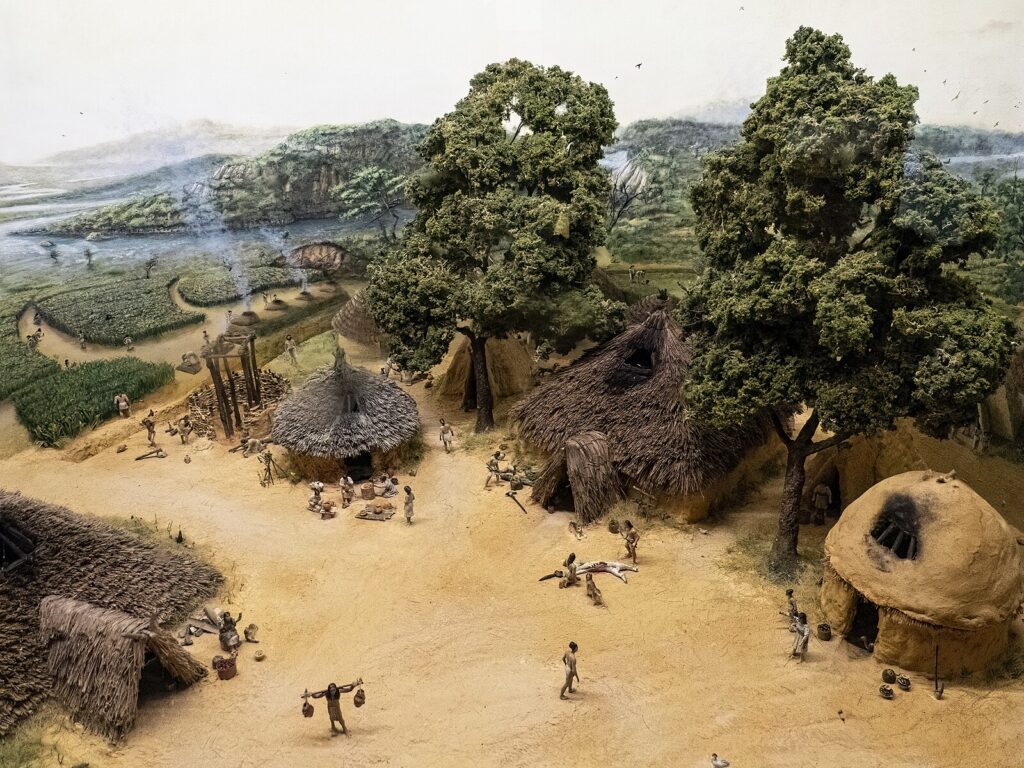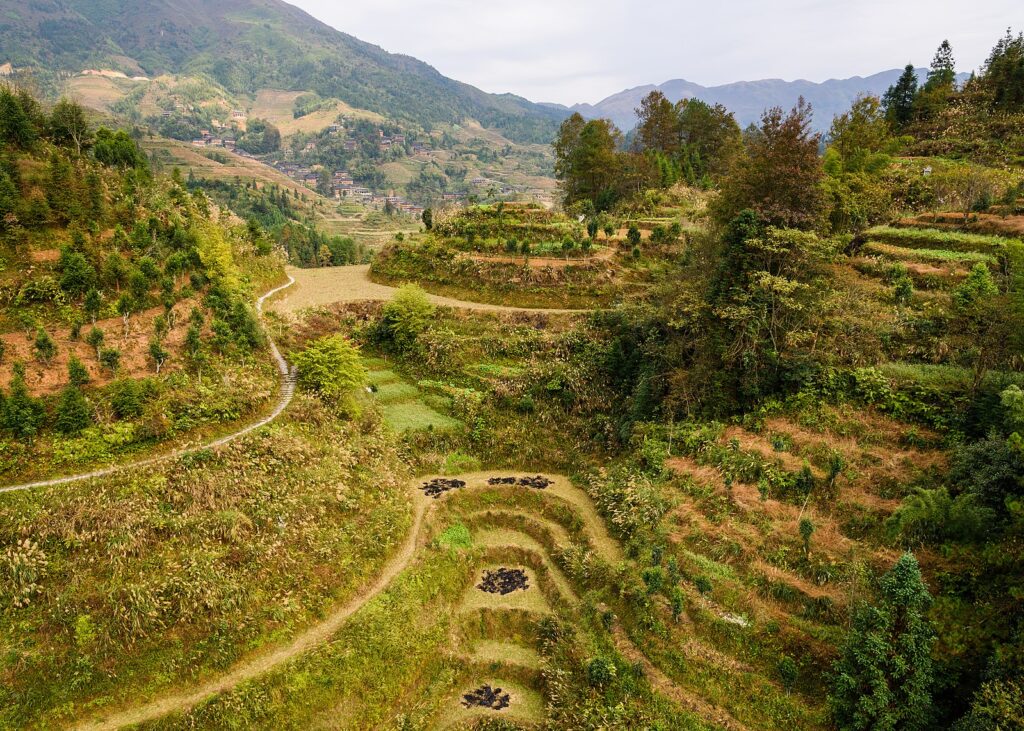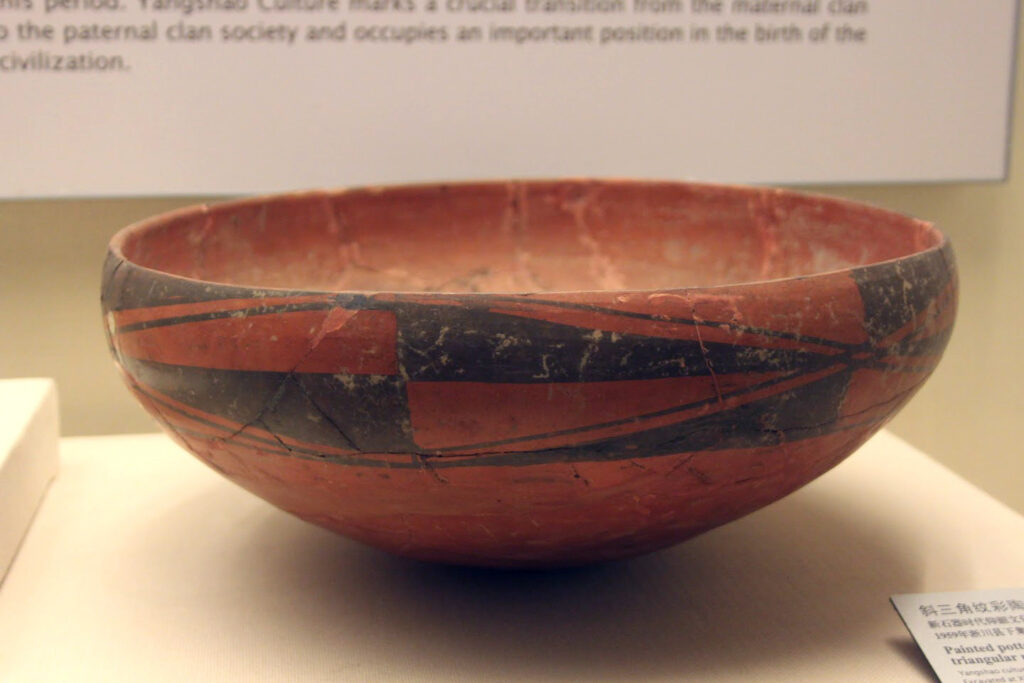Ancient China is an extremely broad period. The country spans a huge swatch of the Earth and encompasses many thousands of years of history. Any broad generalizations should be taken with a grain of salt.
The archeological record only gives us glimpses into life in the distant past. But much can be learned from those hints and clues.
This article will give you a glimpse into what life in China was like during prehistoric times and then during the Bronze Age.

Prehistoric China
Agriculture began in China over eight thousand years ago, maybe even ten thousand years ago.
The earliest evidence of rice cultivation was found near the Yangtze River and carbon-dated to eight thousand years ago. Evidence of millet agriculture has been dated to about seven thousand years ago along the Yellow River. Soybeans followed soon after.
In addition to cultivating these grains and beans, these early peoples gathered wild fruits such as apricots and pears. They also foraged for chestnuts, acorns, and edible roots.
Eventually, they domesticated dogs, birds, pigs, and cattle. This was supplemented with wild meat from cranes, rabbits, deer, and fish. They used arrows, barbed harpoons, and fishing nets.
With such a plentiful food supply, lifespans increased and infant mortality was relatively low.

Life in the Villages
There were settled villages throughout China in sites such as the Yellow River valley. These villages typically consisted of round wooden houses with thatched roots.
Some villages, such as Banpo and Jiahu, were surrounded by wide ditches – most likely used as defensive moats. These fortifications seem to have been effective deterrents to any groups that may have threatened them, because there is little evidence of violent deaths among these villagers.
Over eight thousand years ago, people in Jiahu began carving flutes out of the wing-bones of cranes. These are some of the oldest musical instruments ever discovered.
In addition to music, there’s evidence that these people made alcohol using rice, honey, and hawthorn leaves.
Some of these Neolithic villages may have supported as many as eight hundred people at one time. They buried their dead in communal graves near the village.
The kilns that they used to make pottery were also located outside of the village’s protective moat. The earliest potter’s wheels in Chinese history were found here. The designs on their pottery often depicted humans and animals.
The people of Banpo also used a number of symbols that have been classified as a sort of proto-writing, the predecessor to Chinese characters.
Artifacts of the Ancient Civilizations
In addition to pottery, people made woven baskets. Although they likely wore animal skins as their primary clothing, evidence of spinning looms suggests that they were also capable of making cloth, most likely using hemp fiber.
When the Banpo archeological site was first excavated in 1953, Marxist historians believed that the people who inhabited this ancient village had a matriarchal culture. This view has gradually fallen out of favor, and little information about the village’s social structure can be gleaned from the current archeological findings.

Towards the end of the Neolithic period, the Longshan culture began producing highly sophisticated black pottery with thin walls and complex shapes. The Longshan culture was also capable of farming silkworms and using their cocoons to make fabric.
Their principal crop was millet; they also cultivated rice and wheat. They ate pigs, sheep, goats, and dogs.
Walls of rammed Earth became common around 2600 BC, and the introduction of military weapons such as the dagger-ax suggests increased warfare around this time.
The oldest arsenic-containing copper ever found was created in the village of Jiangzhai in the Yellow River basin over six thousand years ago.
Copper bells, rings, and tools became increasingly common at this time, setting the scene for the Bronze Age cultures that would follow.

Bronze-Age China
Writing
Perhaps the earliest Bronze Age culture in China – and arguably the first state-level society – was the Erlitou culture. It began in the Yellow River valley around 1900 BC and spread throughout the region.
The principal city of Erlitou had a population of around 24,000 people at its peak, supporting a large palatial complex. They produced a great deal of bronze. Ornamental bronze objects were often inlaid with turquoise.
Symbols were increasingly common but have not yet been deciphered. While they may be linked to early Chinese characters, they were probably still a form of proto-writing, or marks capable of communicating only limited bits of information.
The Shang Dynasty, also known as the Yin Dynasty, began around 1600 BC. This rich period of history has given us tens of thousands of bronze, bone, jade, stone, and ceramic artifacts.
Chinese writing originated during the Shang Dynasty around 1250 BC. The oldest examples are found inscribed on oracle bones such as turtle shells and animal scapulae. These characters were scratched into the surface to ask a question, and heating the oracle bones until cracks formed would supply an answer.
Diet, Clothing, and Cultural Practices
The mainstay of their diet was rice with vegetables, supplemented with eggs and fish. Cooking was done in dings, three-legged metal pots that sat over a fire and allowed food to cook slowly all day while families worked out in the fields.
Tea did not become a common part of Chinese food culture until around 100 BC.
Hemp clothing was common by this point, and the very highest members of the nobility wore silk. Women wore ankle-length dresses tied at the waist, and men typically wore tunics down to their knees. Padded hemp jackets were added in the winter.
Animal images, usually tigers and sometimes snakes or toads, were embroidered onto clothing for decorative and protective purposes.
Hair was worn long, usually tied up but never cut (as doing so was considered to be disrespectful towards one’s ancestors).
The practice of foot binding began three thousand years ago. It originated amongst the upper classes and eventually became commonplace for all Chinese women. The feet of small girls were bound so tightly that their toes grew curled beneath the rest of their feet.
Ancient paintings show women crawling in the rice paddies to do their work because it was so painful to walk on their deformed toes. The practice was finally outlawed in 1911 CE.

